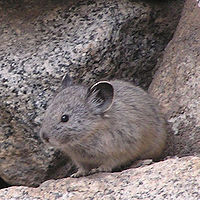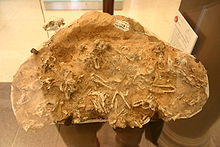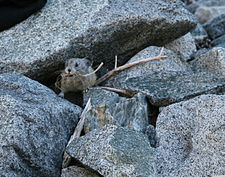- Pika
-
Pika[1]
Temporal range: Oligocene–Recent[2]
American Pika, (Ochotona princeps), in Sequoia National Park Scientific classification Kingdom: Animalia Phylum: Chordata Class: Mammalia Order: Lagomorpha Family: Ochotonidae
Thomas, 1897Genus: Ochotona
Link, 1795Type species Ochotona minor
Link, 1795
(Lepus dauuricus Pallas, 1776)Species See text
The pika (
 /ˈpaɪkə/ py-kə; archaically spelled pica) is a small mammal, with short limbs, rounded ears, and short tail. The name pika is used for any member of the Ochotonidae, a family within the order of lagomorphs, which also includes the Leporidae (rabbits and hares). One genus, Ochotona, is recognised within the family, and it includes 30 species.[citation needed] It is also known as the "whistling hare" due to its high-pitched alarm call when diving into its burrow. The name "pika" appears to be derived from the Tungus piika.
/ˈpaɪkə/ py-kə; archaically spelled pica) is a small mammal, with short limbs, rounded ears, and short tail. The name pika is used for any member of the Ochotonidae, a family within the order of lagomorphs, which also includes the Leporidae (rabbits and hares). One genus, Ochotona, is recognised within the family, and it includes 30 species.[citation needed] It is also known as the "whistling hare" due to its high-pitched alarm call when diving into its burrow. The name "pika" appears to be derived from the Tungus piika.Contents
Habitat
Pikas are native to cold climates, mostly in Asia, North America and parts of eastern Europe. Most species live on rocky mountain sides, where there are numerous crevices to shelter in, although some also construct crude burrows. A few burrowing species are instead native to open steppe land. In the mountains of Eurasia, pikas often share their burrows with snowfinches, which build their nests there.[3]
Characteristics
Pikas are small mammals, with short limbs, rounded ears, and short tails. They are about 6-9 in. in body length, with a tail less than 2 cm long, and weigh between 120 and 350 grams, depending on species. Like rabbits, after eating they initially produce soft green feces, which they eat again to extract further nutrition, before producing the final, solid, fecal pellets.
These animals are herbivores, and feed on a wide variety of plant matter. Because of their native habitat, they primarily eat grasses, sedges, shrub twigs, moss, and lichen. As with other lagomorphs, pikas have gnawing incisors and no canines, although they have fewer molars than rabbits, giving them a dental formula of:

Rock-dwelling pikas have small litters of fewer than five young, while the burrowing species tend to give birth to more young, and to breed more frequently, possibly due to a greater availability of resources in their native habitats. The young are born after a gestation period of between 25 and 30 days.[3]
Activity
Pikas are diurnal or crepuscular, with higher altitude species generally being more active during the daytime. They show their peak activity before the winter season. Pikas do not hibernate, so they rely on collected hay for warm bedding and food. Pikas gather fresh grasses and lay them in stacks to dry. Once the grasses dry out, the pikas take this hay back to the burrows for storage. It is not uncommon for pikas to steal hay from others; the resulting disputes are usually exploited by neighboring predators like ferrets and large birds.
Eurasian pikas commonly live in family groups and share duties of gathering food and keeping watch. At least some species are territorial. North American pikas (O. princeps and O. collaris) are asocial, leading solitary lives outside the breeding season.
Species
There are 30 species listed.
- Order Lagomorpha[1]
- Family Ochotonidae: pikas
- Genus Ochotona
- Subgenus Pika: northern pikas
- Alpine Pika/Altai Pika, Ochotona alpina
- Silver Pika, Ochotona argentata
- Collared Pika, Ochotona collaris
- Hoffmann's Pika, Ochotona hoffmanni
- Northern Pika/Siberian Pika, Ochotona hyperborea
- Pallas's Pika, Ochotona pallasi
- American Pika, Ochotona princeps
- Turuchan Pika, Ochotona turuchanensis
- Subgenus Ochotona: shrub-steppe pikas
- Gansu Pika/Gray Pika, Ochotona cansus
- Plateau Pika/Black-lipped Pika, Ochotona curzoniae
- Daurian Pika, Ochotona dauurica
- Tsing-ling Pika, Ochotona huangensis
- Nubra Pika, Ochotona nubrica
- Steppe Pika, Ochotona pusilla
- Afghan Pika, Ochotona rufescens
- Moupin Pika, Ochotona thibetana
- Thomas's Pika, Ochotona thomasi
- Subgenus Conothoa: mountain pikas
- Chinese Red Pika, Ochotona erythrotis
- Forrest's Pika, Ochotona forresti
- Gaoligong Pika, Ochotona gaoligongensis
- Glover's Pika, Ochotona gloveri
- Himalayan Pika, Ochotona himalayana
- Ili Pika, Ochotona iliensis
- Kozlov's Pika, Ochotona koslowi
- Ladak Pika, Ochotona ladacensis
- Large-eared Pika, Ochotona macrotis
- Muli Pika, Ochotona muliensis
- Black Pika, Ochotona nigritia
- Royle's Pika, Ochotona roylei
- Turkestan Red Pika, Ochotona rutila
- Subgenus Pika: northern pikas
- Genus Ochotona
- Family Ochotonidae: pikas
References
- ^ a b Hoffman, Robert S.; Smith, Andrew T. (16 November 2005). "Order Lagomorpha (pp. 185-211". In Wilson, Don E., and Reeder, DeeAnn M., eds. Mammal Species of the World: A Taxonomic and Geographic Reference (3rd ed.). Baltimore: Johns Hopkins University Press, 2 vols. (2142 pp.). pp. 185–193. ISBN 978-0-8018-8221-0. OCLC 62265494. http://www.bucknell.edu/msw3.
- ^ Savage, RJG, & Long, MR (1986). Mammal Evolution: an illustrated guide. New York: Facts on File. pp. 128. ISBN 0-8160-1194-X.
- ^ a b Kawamichi, Takeo (1984). Macdonald, D.. ed. The Encyclopedia of Mammals. New York: Facts on File. pp. 726–727. ISBN 0-87196-871-1.
External links
- The Trek of the Pika "A story complete with sounds of pika calls" 30 October 2002
- [1] "A radio feature on how Pikas in the Rockies are coping with climate change. " 31 July 2007
 This article incorporates text from a publication now in the public domain: Chisholm, Hugh, ed (1911). Encyclopædia Britannica (11th ed.). Cambridge University Press.
This article incorporates text from a publication now in the public domain: Chisholm, Hugh, ed (1911). Encyclopædia Britannica (11th ed.). Cambridge University Press.
Categories:- Pikas
- Monogeneric animal families
- Order Lagomorpha[1]
Wikimedia Foundation. 2010.



